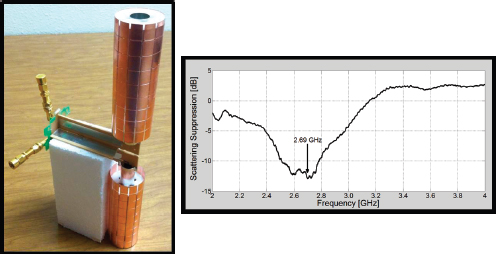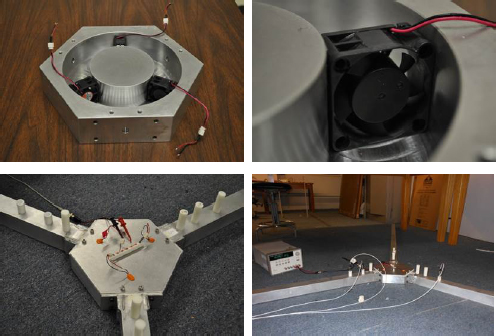Metamaterial-based Device Engineering
ANDREA ALÙ
The University of Texas at Austin
Metamaterials are artificial materials with unusual bulk properties (Engheta and Ziolkowski 2006) based on suitably designed arrays of complex resonant subwavelength elements. By definition, metamaterials have properties not available in any of their constituents (or in any natural material). These properties emerge from strong wave-matter interactions and carefully engineered mesoscopic structures.
In the past decade, metamaterials have opened several exciting directions in basic science, such as the realization of artificial plasmas at microwaves, artificial magnetism in optics, negative refraction, cloaking and extreme scattering manipulation, and large wave control over surfaces significantly thinner than the wavelength. These features not only are shedding light on fascinating new areas for basic research in optics, electromagnetics, acoustics, and beyond, but also are yielding important, direct applications in more applied engineering contexts.
I briefly review recent impacts of metamaterials in a few engineering fields where they have helped overcome some long-standing challenges for technology.
CLOAKING AND RADIO-TRANSPARENT ANTENNAS
Invisibility has been a tantalizing concept in human culture for several centuries. In engineering, the ability to cloak objects is very important for camouflaging and noninvasive biomedical sensing, to name just two applications. With recent developments in metamaterial science and technology, the possibility of cloaking objects against electromagnetic radiation has escaped from the realm of science fiction to become a technological reality (Alù and Engheta 2005; Schurig et al. 2006).
Given inherent challenges in substantially suppressing the scattering from objects that are many wavelengths large with a passive coating (Monticone and Alù

FIGURE 1 Left: A cloaked dipole antenna, which can transmit and receive signals while producing significantly less scattering than a bare antenna. Right: Measured scattering gain, defined as the ratio (in decibels, dB) between a bare dipole and a cloaked one. Adapted from Soric et al. (2015).
2013), a viable application of cloaking technology is in the area of radio frequency–cloaked antennas or radiators, whose size is comparable to the wavelength and therefore allows considerable scattering suppression over large bandwidths.
In our group, we have worked for several years on radiowave cloaking applications (Alù 2009; Monti et al. 2012) and have recently shown that conventional antennas can be cloaked with suitably designed metasurfaces to greatly reduce scattering from radio waves while preserving the possibility of transmitting and receiving signals over large bandwidths of operation (Soric et al., 2015). Figure 1 shows a cloaked dipole antenna for cellular communications; it largely suppresses radar cross-section at all angles, compared to a bare dipole, while transmitting and receiving radio frequency signals with good matching and isolation performance over the entire cellular band.
AN INVISIBLE ACOUSTIC SENSOR
Cloaking a sensor or receiving antenna is challenging because the action of sensing requires extracting a portion of the impinging signal and thus creating a shadow (Fleury et al. 2014a). Schemes that involve active (instead of passive) circuit elements to realize more advanced metamaterials provide a way around this limitation.
Inspired by recent advances in quantum mechanics in the area of parity-time (PT) symmetry, we have shown that it is possible to realize an invisible acoustic

FIGURE 2 An invisible acoustic sensor based on parity time (PT) symmetric meta-atoms in the form of loudspeakers loaded by circuit components with conjugate impedances. The setup enables a shadow-free efficient acoustic sensor. ZL represents the loading impedances on the two loudspeakers: the one on the left is passive, and the one on the right is its time-reversed image and therefore active. Adapted from Fleury et al. (2015a).
sensor with strong absorption properties by pairing a resonant sensor with its time-reversed image (Figure 2; Fleury et al. 2015a). This device can absorb the entire incoming signal without creating any shadow or reflection. The system was built by pairing in free space two identical loudspeakers loaded by circuits with conjugate impedances: one passive, for converting the impinging sound into a voltage across a resistor, the second active, for emitting a signal, in sync with the impinging one, that suppresses shadows and reflections.
This class of PT-symmetric sensors can also be used as the basis of PT-symmetric metamaterials, to realize loss-free negative index aberration-free planar lenses (Fleury et al. 2014b) and advanced cloaks (Sounas et al. 2015).
NONRECIPROCAL MAGNET-FREE DEVICES
Sound, light, and many other waves tend to travel symmetrically in space: if a signal can be sent from point A to B, then it can typically be sent from B to A. This symmetry, known as reciprocity, is due to the fact that wave propagation in conventional media, including light and sound, is time reversible.
Reciprocity is not necessarily desirable, however, especially when one wants to isolate a source from its echo or separate signal flows travelling in opposite directions. To enable full-duplex communication—the transmission and receipt of signals from the same transducer on the same frequency channel—which may lead to more efficient radiowave communications or better ultrasound imaging devices, it may be necessary to break reciprocity.
The most common way to break reciprocity is based on magnetic bias, but this method has several challenges, including the use of scarce materials and difficulty integrating them on-chip. We recently proved that reciprocity can be broken by applying an angular momentum bias to a metamaterial cavity, obtained by loading a hollow cavity with small fans, enabling the first-of-its-kind circulator for acoustic waves (Figure 3; Fleury et al. 2014c).

FIGURE 3 A table-top circulator that breaks the symmetry of acoustic wave travel in air. It is formed by a circularly symmetric cavity loaded with three CPU fans (upper right) that move air at a moderate velocity that is enough to break reciprocity and enable large isolation. The cavity is connected to three acoustic waveguides (bottom left) carrying sound signals. Adapted from Fleury et al. (2014c).
The system is a basic three-port device that allows one-way rotation of the input signals—from port 1 to 2, 2 to 3, and 3 to 1—while preventing transmission in the opposite direction. Very large isolation (over 40 decibels) was realized for airborne acoustic waves using a suitably designed subwavelength acoustic ring cavity in which air was rotated simply by using fans, and the cavity was symmetrically coupled to three acoustic waveguides, which formed the input and output channels of the device.
While it is interesting to see how such a basic active component can modify the way sound propagates, a mechanical motion of the material in the cavity may not always be convenient or practical, especially when translating these effects to other types of waves, such as radio signals, which travel much faster than sound. Estep and colleagues (2014) and Fleury and colleagues (2015b) extended these concepts to an equivalent meta-atom in which fluid motion was replaced by spatio-temporal modulation of three strongly coupled resonators, realizing magnet-free circulators for radio and ultrasound waves. Magnet-free circulators may enable cell-phone and handset devices with non-reciprocal, circuit-based components, a
crucial development to realize full-duplex communications, that is, to be able to transmit and receive through the same antenna, on the same frequency channel, and at the same time.
CONCLUSIONS
The field of metamaterials has opened exciting directions in basic research in the past 15 years, but only recently has it become a platform for important opportunities in applied technology, with implications for many engineering fields. In this work, we have reviewed the application of metamaterials to scattering suppression and non-reciprocal wave propagation, with specific attention to its impact on practical applications of interest to the engineering world.
ACKNOWLEDGMENT
This work was supported by the Department of Defense and the National Science Foundation.
REFERENCES
Alù A. 2009. Mantle cloak: Invisibility induced by a surface. Physical Review B 80(24):245115.
Alù A, Engheta N. 2005. Achieving transparency with plasmonic and metamaterial coatings. Physical Review E 72(1):016623.
Engheta N, Ziolkowski RW. 2006. Metamaterials: Physics and Engineering Explorations. Hoboken, NJ: John Wiley & Sons.
Estep N, Sounas D, Soric J, Alù A. 2014. Magnetic-free non-reciprocity based on parametrically modulated coupled-resonator loops. Nature Physics 10(12):923–927.
Fleury R, Soric J, Alù A. 2014a. Physical bounds on absorption and scattering for cloaked sensors. Physical Review B 89(4):045122.
Fleury R, Sounas D, Alù A. 2014b. Negative refraction and planar focusing based on parity-time symmetric metasurfaces. Physical Review Letters 113(2):023903.
Fleury R, Sounas DL, Sieck CF, Haberman MR, Alù A. 2014c. Sound isolation and giant linear nonreciprocity in a compact acoustic circulator. Science 343(6170):516–519.
Fleury R, Sounas DL, Alù A. 2015a. An invisible acoustic sensor based on parity-time symmetry. Nature Communications 6:5905.
Fleury R, Sounas DL, Alù A. 2015b. Subwavelength ultrasonic circulator based on spatio-temporal modulation. Physical Review B 91(17):174306.
Monti A, Soric J, Alù A, Toscano A, Vegni L, Bilotti F. 2012. Overcoming mutual blockage between neighboring dipole antennas using a low-profile patterned metasurface. IEEE Antennas and Wireless Propagation Letters 11:1414–1417.
Monticone F, Alù A. 2013. Do cloaked objects really scatter less? Physical Review X 3(4):041005.
Schurig D, Mock JJ, Justice BJ, Cummer SA, Pendry JB, Starr AF, Smith DR. 2006. Metamaterial electromagnetic cloak at microwave frequencies. Science 314(5801):977–980.
Soric J, Monti A, Toscano A, Bilotti F, Alù A. 2015. Dual-polarized reduction of dipole antenna blockage using metasurface cloaks. IEEE Transactions on Antennas and Propagation 63(11):4027–4034.
Sounas DL, Fleury R, Alù A. 2015. Unidirectional cloaking based on metasurfaces with balanced loss and gain. Physical Review Applied 4(1):014005.
This page intentionally left blank.






